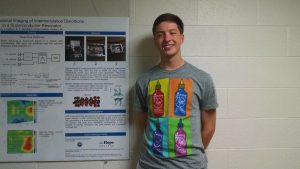
Research Advisor: Dr. Stephen Remillard
At the resonant frequency, superconductor resonators produce intermodulation distortions, smaller signals near the resonant frequency. By inducing external microwave signals, it is possible to analyse the patterns of intermodulation distortions (IMD) in several different types of superconductor resonators. These measurements can be used to complement the main peak values like quality factor and frequency shift in order to understand nonlinearities present in the material of the superconductor. Once spatial distributions of IMD have been identified, they can be used to interpret IMD signals from unknown superconductors and identify various defects in the crystal structure. Using a probe outputting two combined tones into the resonator, it was possible to map the whole of a two-dimensional resonator, using the IMD as the z-direction. In order to best resolve the intermodulation distortions, two superconductors were imaged, a hairpin wide-line resonator and a thin, line resonator. A contour plot of the data was then generated, which displays the IMD of the given resonator.
Funding for this project was provided by The Hope College Natural and Applied Sciences Division and Award number DMR-1505617 from the National Science Foundation.